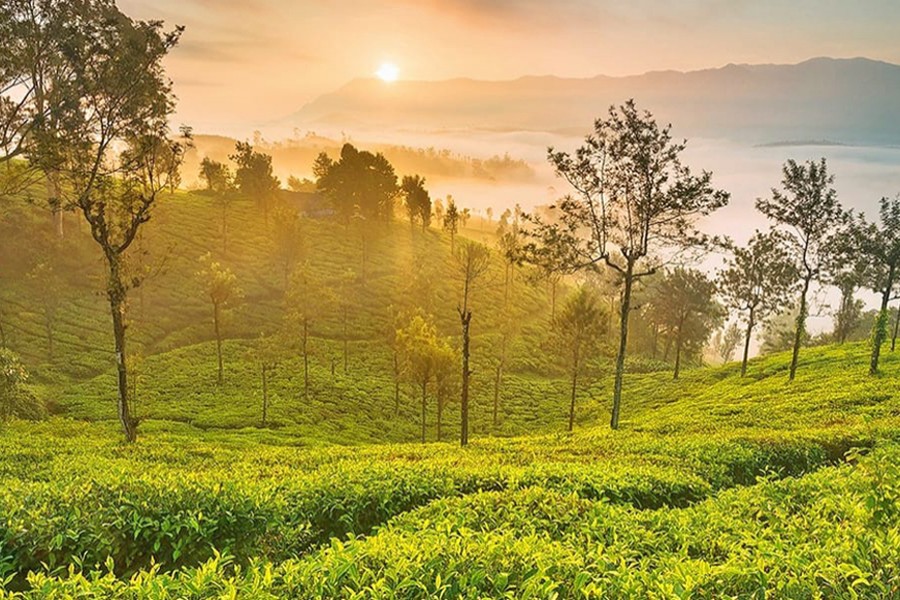On way to Ooty, lovingly called the Queen of the South. A cradle of Nature's bounties, Ooty is blessed with an eternal spring season. The highest temperature usually persists on an average between 17-20 degrees and the lowest average is between 5-12 degrees. Located in the Nilgiris biosphere reserve, it is situated at 7,350 feet above sea level.
As we drove from the Bandipur safari park, there was no end to the forest soon. At some point we entered the Namil Nadu part of it where the deer and monkey could also be seen in large herds on both sides of the road. After about two hours' drive, out of the woodland the scene started changing. On the roadside, the trees were more like those of Bangladesh with an abundance of Neem trees, banana orchards and other local species. There were plain lands on our right where croplands stretched for miles but no villages or even dwelling houses apart from vegetation could be spotted. However, water melon, green coconut and a few other local fruits kept in stacks on roadside could be seen within a kilometer or two. On the left, presumably undulating lands steeped down giving an impression that a sea was nearby.
Then again, the roadside trees started giving an unfamiliar look. Our eyes met a hill at a considerable distance. These trees a little larger than shrubs somewhere in between guava and jarul were of 10-12 feet high and as we approached the hill, the road pierced through it making its winding way at times at 360-degree angles. The elevation and elongation of the road take test of a driver's skills, manoeuvrability and nerves but ours was a driver who, at no point, did give us any cause for getting panicky. We had sacrificed our breakfast because there was so much to see in Ooty but we had planned to be on our journey to Kanyakumari.
But to borrow the wise words from Hippocrates and give the famous saying a twist: time (instead of life) is short but art is long, we had for the first time on our tour rued over the missing of an overnight stay at that scenic hilly resort. What we saw was a lifetime's experience but now I know we missed more than what we had come across. It is because each tourist attraction has its especial charm and appeal. It was really foolish not to visit the botanical garden which is one of its kind.
However, our most enthralling encounter was with a piece of Eden cut out on the slopes of the Elk Hill. They call it Rose Garden. I would rather rechristen it to myself as a valley of Eden but for the painstaking terraces made by man where as many as 3,600 varieties of roses unfold their ethereal beauty and entice visitors with magical fragrance. Apart from the roses we know for their common colours, there are roses white, blue and black. Some of the roses are quite large, others are of usual sizes. Then some have been cultured of the sizes of morning glories and even tulips in clusters. What is particularly notable is that each species has been named after either its collector or some famous personality from social workers, poet to political leaders. Surprisingly, a Margaret Thatcher rose was also found to pay tribute to the Iron Lady. It was not clear why. There were topiaries and gazebos also in the rose garden. These things are common in botanical gardens and parks we visited elsewhere in South India. Most of rose plants were however pale with no lush growth. Maybe, June is not an ideal time for viewing the garden's glory.
It was time for lunch. For the first time the meal was to our liking. There were all kinds of foods -from the local to the continental. We realised later why people lined up to get entry into the eatery called Hyedrabad Biryani House. After lunch we moved to the tea and hand-crafted chocolate factory. Yes, my daughter and son bought plentiful of the delicacies from the latter. But at the tea factory it was a disappointment. Then we visited the highest peak of the Nilgiri Hills locally called Doddabetta at a height of 2,637 metres. Road access to the spot makes it unusually crowded with footpath vendors typically exhibiting everything from green mangoes to popcorn to jhal muri to cheap ornaments and artefacts. It may be a popular tourist spot from where a full view of Ooty is obtained but it could easily be observed that the heavy rush was spoiling the place. There is a need for restricting the stream of visitors if even a semblance of its pristine beauty has to be preserved.
The sun was setting in the distance spreading its fading glows on the hilltops all around. In the clamouring crowd too, I became lonely I do not know why. Was it because man spoils Nature for his own pleasure or because commercial interests are contradictory to feel the togetherness with any place of great scenic beauty? Anyway, we are heading for Coimbatore.


